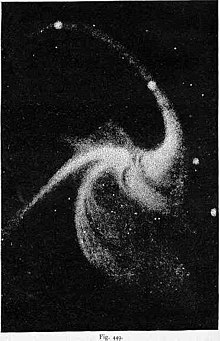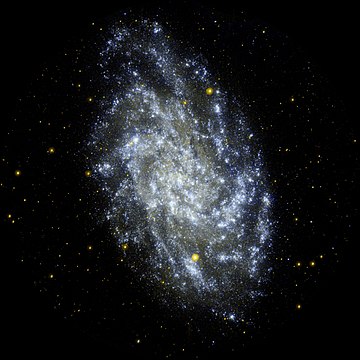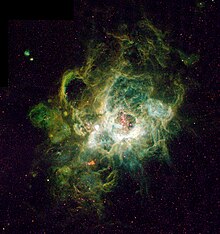Triangle nebula
| Galaxy triangle nebula |
|
|---|---|

|
|
| Visual recording with the 60 cm telescope of the Lohrmann Observatory . | |
| AladinLite | |
| Constellation | triangle |
|
Position equinox : J2000.0 , epoch : J2000.0 |
|
| Right ascension | 01 h 33 m 50.9 s |
| declination | + 30 ° 39 ′ 37 ″ |
| Appearance | |
| Morphological type | SA (s) cd / HII |
| Brightness (visual) | 5.5 mag |
| Brightness (B-band) | 6.2 mag |
| Angular expansion | 68.7 ′ × 41.6 ′ |
| Position angle | 23 ° |
| Surface brightness | 14.0 mag / arcmin² |
| Physical data | |
| Affiliation |
Local group , Andromeda subgroup, LGG 011 |
| Redshift | −0.000597 ± 0.000010 |
| Radial velocity | −179 ± 3 km / s |
| distance | 2.76 ± 0.11 million ly / 847,000 ± 35,000 pc |
| Absolute brightness | −18.9 mag |
| diameter | 50,000 - 60,000 years |
| history | |
| discovery |
Giovanni Battista Hodierna / Charles Messier |
| Discovery date | around 1654 |
| Catalog names | |
| M 33 • NGC 598 • UGC 1117 • PGC 5818 • CGCG 502-110 • MCG + 5-4-69 • IRAS 01310 + 3024 • 2MASX J01335090 + 3039357 • GC 352 • H V-17 • h 131 • | |
The Triangle Nebula , also known as the Triangular Galaxy and the Triangulum Nebula or Messier 33 , is a spiral galaxy with the dimensions 70 '× 40' and a total brightness of 5.7 mag in the triangle constellation . This makes it the second brightest spiral galaxy in the night sky after the Andromeda Nebula and one of the closest to us.
However, its brightness is distributed over a larger area, so that under normal conditions it is not free-eyed , but only visible through binoculars . Therefore about 20 distant galaxies are easier to observe in the telescope.
history
The Triangle Nebula was discovered by Giovanni Battista Hodierna around 1654 and recorded by Charles Messier on August 25, 1764 . Other early observations were made by Johann Elert Bode (1775), William Herschel (1784) and John Herschel (1828).
description
With a diameter of about 50,000–60,000 light years, the Triangle Nebula is the third largest object in the Local Group after the Andromeda Nebula (≈ 150,000 ly; Halo 240 kpc ) and the Milky Way (≈ 100,000 ly; Halo 50 kpc) .
The object listed in the Messier catalog as M33 was the second galaxy after M51 in which Lord Rosse could imagine a spiral structure with his giant telescope in 1845 . The existence of these spiral arms has long been doubted by other astronomers.
The distance from the earth to the triangle nebula is almost three million light years . The baryonic mass of this spiral galaxy (stars and gas) is about two percent of the mass of the Milky Way system, or four to six billion solar masses . Together with the surrounding dark matter, it should be around 50 billion solar masses.
Possibly the Triangle Nebula is gravitationally bound to the Andromeda Nebula, from which it is about a million light years away.
Ultraviolet image taken by GALEX
Image in the mid- infrared spectrum , Spitzer space telescope
Far infrared image, Herschel space telescope
Proper movement
The galaxy could potentially hit the Milky Way's collision path with the Andromeda galaxy .
In 2005 a German team of researchers succeeded in using the VLBA to set up a model for the rotation and proper motion of the triangular nebula by observing H 2 O measles on opposite sides of the spiral galaxy . The team came to the conclusion that the galaxy moves with a proper motion of −30 ± 8 micro-arcseconds (µ ″ / a) per year in right ascension and 45 ± 9 µ ″ / a in declination. From this, the researchers conclude a total speed of 190 ± 60 km / s relative to the Milky Way system, with the movement roughly pointing in the direction of the Andromeda Nebula. Such measurements have so far only been successful for a few galaxies and represent an essential prerequisite for dynamic models of the local group .
Associated objects
There are a few globular clusters , some of which belong to the rare object class of blue globular clusters , associated with this galaxy. The Triangle Nebula probably also has a satellite galaxy, the Pisces dwarf galaxy .

HII regions
Wilhelm Herschel already noticed the large HII region (a diffuse gas nebula made of ionized hydrogen ) NGC 604 while observing the Triangle Nebula . Herschel perceived this as a separate object and gave it the name H III.150. With a diameter of almost 1500 light years, this huge star formation region is one of the largest known objects of this type and resembles the Orion Nebula in its spectral characteristics . Even amateur telescopes allow observation of this gas nebula, which can be found northeast of the center of the galaxy. Herschel also noticed three smaller HII regions, namely NGC 588 , NGC 592, and NGC 595 .
Individual objects (HII regions) in M33
| Name of the object | Right ascension | declination | m V | Explorer | Discovery date | alternative name |
|---|---|---|---|---|---|---|
| NGC 588 | 01 h 32 m 45.5 s | + 30 ° 38 ′ 56 ″ | 13.5 | Heinrich d'Arrest | October 2, 1861 | BCLMP 280 |
| NGC 592 | 01 h 33 m 11.7 s | + 30 ° 38 ′ 42 ″ | 13 | Heinrich d'Arrest | October 2, 1861 | BCLMP 277 |
| IC 131 | 01 h 33 m 14.6 s | + 30 ° 45 ′ 12 ″ | 14th | Guillaume Bigourdan | October 28, 1889 | BCLMP 290A |
| IC 133 | 01 h 33 m 15.2 s | + 30 ° 53 ′ 18 ″ | 14th | Guillaume Bigourdan | October 28, 1889 | BCLMP 623 |
| IC 132 | 01 h 33 m 15.8 s | + 30 ° 56 ′ 45 ″ | 13.5 | Guillaume Bigourdan | October 28, 1889 | |
| NGC 595 | 01 h 33 m 33.8 s | + 30 ° 41 ′ 30 ″ | 13.1 | Heinrich d'Arrest | October 1, 1864 | BCLMP 49 |
| IC 137 | 01 h 33 m 38.9 s | + 30 ° 31 ′ 21 ″ | 14th | Guillaume Bigourdan | October 28, 1889 | BCLMP 204, 205 |
| BCLMP 62 | 01 h 33 m 44.8 s | + 30 ° 44 ′ 47 ″ | ||||
| BCLMP 25 | 01 h 33 m 45 s | + 30 ° 36 ′ 28 ″ | ||||
| IC 142 | 01 h 33 m 55.5 s | + 30 ° 45 ′ 28 ″ | 14.2 | Guillaume Bigourdan | October 28, 1889 | BCLMP 301 |
| IC 140 | 01 h 33 m 58.2 s | + 30 ° 33 '00 ″ | 13 | Guillaume Bigourdan | October 28, 1889 | |
| IC 139 | 01 h 33 m 59.2 s | + 30 ° 34 ′ 03 ″ | 14th | Guillaume Bigourdan | October 28, 1889 | BCLMP 8A |
| IC 143 | 01 h 34 m 11.1 s | + 30 ° 46 ′ 41 ″ | 14th | Guillaume Bigourdan | October 28, 1889 | BCLMP 688 |
| IC 135 | 01 h 34 m 15.5 s | + 30 ° 37 ′ 12 ″ | 14th | Guillaume Bigourdan | October 28, 1889 | BCLMP 88 |
| IC 136 | 01 h 34 m 13.7 s | + 30 ° 33 ′ 35 ″ | 13.7 | Guillaume Bigourdan | October 28, 1889 | BCLMP 711 |
| BCLMP 691 | 01 h 34 m 16.4 s | + 30 ° 51 ′ 55 ″ | ||||
| NGC 604 | 01 h 34 m 33.2 s | + 30 ° 47 ′ 06 ″ | 12 | William Herschel | September 11, 1784 | BCLMP 680 |
M33 X-7
In October 2007, researchers used the Chandra X-ray telescope to discover the galaxy's most massive black hole at the time , which developed from a single star. At that time, more massive black holes are only known from the cores of galaxies, where these objects continue to enlarge due to the collapse of matter. The object, which was named M33 X-7 as an X-ray source , is estimated to be just under 16 solar masses. It is in orbit around an extraordinarily large star with about 70 times the mass of the Sun, which is probably a blue giant star . According to previous findings by researchers, stellar black holes actually have an upper mass limit of around 15 solar masses.
visibility

Because of its large angular extent and the resulting low surface brightness , the triangular nebula can hardly be found with small telescopes at too high a magnification. It is recommended to use a bright binoculars , about 15x70 or 20x80. A free-eyed sighting of the galaxy is only possible under very good conditions (close to the zenith, no moon, low light pollution). This means that the triangle nebula is also the most distant object visible to the naked eye.
Web links
- M33 at SEDS
- Lord Rosse's drawing of M33
- Amateur shot with a four-inch telescope
- Huge star corpse: Largest stellar black hole discovered . Spiegel Online , accessed November 6, 2010 (video).
- ESO : VST snapshot of the triangle galaxy with - with map, photos & animation August 6, 2014
- Spektrum.de : Collection of amateur recordings
Individual evidence
- ↑ SIMBAD database
- ↑ a b c NASA / IPAC Extragalactic Database (NED)
- ↑ a b c d Students for the Exploration and Development of Space
- ↑ Igor D. Karachentsev, Valentina E. Karachentseva, Walter K. Huchtmeier, Dmitry I. Makarov: A Catalog of Neighboring Galaxies . In: Astronomical Journal . tape 127 , 2004, pp. 2031-2068 , doi : 10.1086 / 382905 ( ADS , English).
- ^ A b David Darling: Triangulum Galaxy. The Worlds of David Darling, February 27, 2008, accessed March 6, 2010 .
- ↑ a b NGC 598 (= PGC 5818 = M33), the Triangulum Galaxy. In: cseligman.com. Retrieved July 28, 2018 .
- ^ Edvige Corbelli: Dark matter and visible baryons in M33. In: Monthly Notices of the Royal Astronomical Society. Volume 342, No. 1, June 2003, pp. 199-207, doi: 10.1046 / j.1365-8711.2003.06531.x
- ↑ NASA's Hubble Shows Milky Way is Destined for Head-On Collision. NASA May 31, 2012, archived from the original on July 1, 2014 ; accessed on November 12, 2015 .
- ^ Andreas Brunthaler, Mark J. Reid, Heino Falcke, Lincoln J. Greenhill, Christian Henkel ,: The Geometric Distance and Proper Motion of the Triangulum Galaxy (M33) . In: Science . 307, No. 5714, 2005, pp. 1440-1443. doi : 10.1126 / science.1108342 .
- ↑ Ronald Stoyan: Atlas of the Messier objects. Oculum-Verlag, Erlangen 2006, ISBN 978-3-938469-07-1
- ↑ Chandra press release, October 17, 2007










